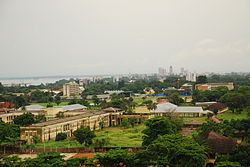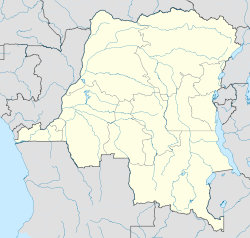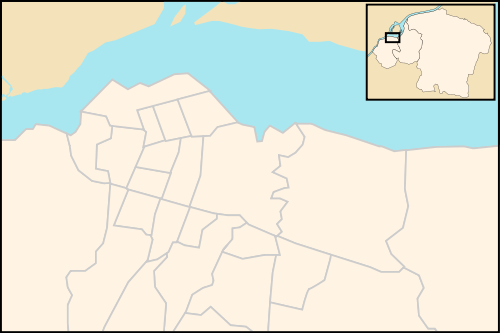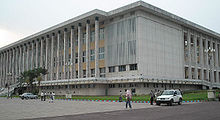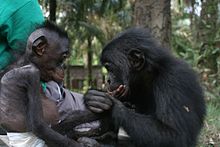- Kinshasa
-
Kinshasa
Ville de Kinshasa— Ville-province (city-province) — Kinshasa with Congo river in background 
Flag
SealNickname(s): Kin la belle
(English: Kin the beautiful)DRC, highlighting the city-province of Kinshasa
DRC, highlighting the city-province of Kinshasa Coordinates: 4°19′30″S 15°19′20″E / 4.325°S 15.32222°ECoordinates: 4°19′30″S 15°19′20″E / 4.325°S 15.32222°E Country  Democratic Republic of the Congo
Democratic Republic of the CongoProvince Kinshasa Administrative HQ La Gombe Communes List- Bandalungwa
- Barumbu
- Bumbu
- Gombe
- Kalamu
- Kasa-Vubu
- Kimbanseke
- Kinshasa
- Kintambo
- Kisenso
- Lemba
- Limete
- Lingwala
- Makala
- Maluku
- Masina
- Matete
- Mont Ngafula
- Ndjili
- Ngaba
- Ngaliema
- Ngiri-Ngiri
- Nsele
- Selembao
Government – Governor André Kimbuta Yango Area[1] – City-province 9,965 km2 (3,847.5 sq mi) Elevation 240 m (787 ft) Population (2009)[1] – City-province 10,076,099 – Density 1,011.1/km2 (2,618.9/sq mi) – Language French Website www.kinshasa.cd Kinshasa (formerly French Léopoldville, and Dutch
 Leopoldstad (help·info)) is the capital and largest city of the Democratic Republic of the Congo. The city is located on the Congo River.
Leopoldstad (help·info)) is the capital and largest city of the Democratic Republic of the Congo. The city is located on the Congo River.Once a site of fishing villages, Kinshasa is now an urban area with a population of over 10 million inhabitants.[1] It faces the capital of the neighbouring Republic of Congo, Brazzaville which can be seen in the distance across the wide Congo River. Because the administrative boundaries cover such a vast area, over 60% of the city's land is rural in nature, and the urban area only occupies a small section in the far western end of the province.[2][3]
Kinshasa holds the status of the third largest city in Africa, after Cairo and Lagos. Although it has no significant native French speaking population, it is the largest officially francophone city in the world, before Paris and Montreal, inasmuch as French is the language of government and commerce, and is used as a lingua franca. If current demographic trends continue, Kinshasa will surpass Paris in population before 2020.[4][5]
Residents of Kinshasa are known as Kinois (French) or Kinshasans (English).
Contents
History
Main article: History of KinshasaThe city was founded as a trading post by Henry Morton Stanley in 1881 and named Léopoldville in honor of King Leopold II of Belgium, who controlled the vast territory that is now the Democratic Republic of the Congo, not as a colony but as a private property. The post flourished as the first navigable port on the Congo River above Livingstone Falls, a series of rapids over 300 kilometres (190 mi) below Leopoldville. At first, all goods arriving by sea or being sent by sea had to be carried by porters between Léopoldville and Matadi, the port below the rapids and 150 km (93 mi) from the coast. The completion of the Matadi-Kinshasa portage railway in 1898 provided a faster and more efficient alternative route around the rapids and sparked the rapid development of Léopoldville. By 1920, the city was elevated to capital of the Belgian Congo, replacing the town of Boma in the Congo estuary.
In 1965, Mobutu Sese Seko seized power in the Congo in his second coup and initiated a policy of "Africanizing" the names of people and places in the country. In 1966, Léopoldville was renamed Kinshasa for a village named Kinchassa that once stood near the site. The city grew rapidly under Mobutu, drawing people from across the country who came in search of their fortunes or to escape ethnic strife elsewhere. This inevitably brought about a change to the city's ethnic and linguistic composition as well. Although it is situated in territory that traditionally belongs to the Bateke and Bahumbu people, the lingua franca in Kinshasa today is Lingala.
In 1974, Kinshasa hosted 'The Rumble in the Jungle' boxing match between Muhammad Ali and George Foreman, in which Ali defeated Foreman to regain the World Heavyweight title.
Kinshasa suffered greatly due to Mobutu's excesses, mass corruption, nepotism and the civil war that led to his downfall. Nevertheless, it is still a major cultural and intellectual center for Central Africa, with a flourishing community of musicians and artists. It is also the country's major industrial center, processing many of the natural products brought from the interior. The city has recently had to fend off rioting soldiers who were protesting the government's failure to pay them.
Kinshasa had the earliest documented HIV-1 infection, which dates from 1959 and was discovered in the preserved blood sample of a local man (see AIDS origin)[6].
Administration
Kinshasa is both a city (ville in French) and a province (province in French), one of the 11 provinces of the Democratic Republic of the Congo. Its status is thus similar to Paris which is both a city and one of the 101 departments of France.
Administrative divisions
Main article: Communes of KinshasaThe ville-province (city-province) of Kinshasa is divided into four districts which are further divided into 24 communes (municipalities).[3] The commune of Kinshasa gave its name to the whole city, but the city's commercial and administrative heart is the commune of Gombe.
Districts and communes of Kinshasa Funa district Lukunga district Mont Amba district Tshangu district Bandalungwa Barumbu Kisenso (Kinsenso) Kimbanseke Bumbu Gombe (La Gombe) Lemba Maluku Kalamu Kinshasa Limete Masina Kasa-Vubu Kintambo Matete Ndjili (N'Djili) Makala Lingwala Ngaba Nsele (N'Sele) Ngiri-Ngiri Mont Ngafula Selembao Ngaliema The 24 communes of Kinshasa  Abbreviations : Kal. (Kalamu), Kin. (Kinshasa), K.-V. (Kasa-Vubu), Ling. (Lingwala), Ng.-Ng. (Ngiri-Ngiri)
Abbreviations : Kal. (Kalamu), Kin. (Kinshasa), K.-V. (Kasa-Vubu), Ling. (Lingwala), Ng.-Ng. (Ngiri-Ngiri)Geography
Kinshasa is a city of sharp contrasts, with affluent residential and commercial areas and three universities coexisting side by side with sprawling slums.
It is located along the south bank of the Congo River, directly opposite the city of Brazzaville, capital of the Republic of the Congo. This is the only place in the world where two national capital cities are facing one another and in sight of each other on opposite banks of a river.
The Congo river is the second longest river in Africa after the Nile, and is the largest in terms of discharge. As a waterway it provides a means of transport for much of the Congo basin, being navigable for large river barges between Kinshasa and Kisangani, and many of its tributaries are navigable too. The river is an important source of hydroelectric power, and downstream of Kinshasa it has the potential to generate power equivalent to the usage of roughly half of Africa's population.[7]
Climate
Under the Koppen climate classification, Kinshasa has a Tropical wet and dry climate. It features a lengthy rainy season which spans from October through May and a relatively short dry season which runs between June and September. Due to fact that Kinshasa lies south of the equator, its dry season begins around its "winter" solstice, which is in June. This is in contrast to African cities further north featuring this climate where the dry season typically begins around January. Kinshasa's dry season is slightly cooler than its wet season, though temperatures remain relatively constant throughout the year.
Climate data for Kinshasa Month Jan Feb Mar Apr May Jun Jul Aug Sep Oct Nov Dec Year Record high °C (°F) 36
(97)36
(97)36
(97)36
(97)35
(95)34
(93)32
(90)35
(95)36
(97)36
(97)34
(93)36
(97)36
(97)Average high °C (°F) 31
(88)31
(88)32
(90)32
(90)31
(88)29
(84)27
(81)29
(84)31
(88)31
(88)31
(88)30
(86)30 Average low °C (°F) 21
(70)22
(72)22
(72)22
(72)22
(72)19
(66)18
(64)18
(64)20
(68)21
(70)22
(72)21
(70)21 Record low °C (°F) 18
(64)18
(64)18
(64)19
(66)18
(64)15
(59)14
(57)14
(57)16
(61)15
(59)17
(63)17
(63)14
(57)Precipitation mm (inches) 135
(5.31)145
(5.71)196
(7.72)196
(7.72)159
(6.26)8
(0.31)3
(0.12)3
(0.12)30
(1.18)119
(4.69)222
(8.74)142
(5.59)1,358
(53.46)Avg. rainy days 11 11 12 16 12 1 0 1 5 11 16 15 111 Sunshine hours 124 140 155 150 155 120 124 155 120 155 150 124 1,672 Source: BBC Weather[8] Buildings and institutions
Major areas of the city include the Cité de l'OUA, home to the Government of the Democratic Republic of the Congo, quartier Matonge, known regionally for its nightlife, L'ONATRA, the impressive building of the Ministry of Transport and the residential area of Gombe.
Notable features of the city include the SOZACOM Building and Hotel Memling skyscrapers, the central market, the Kinshasa Museum and the Kinshasa Fine Arts Academy. The Boulevard du 30 Juin (Boulevard of the 30 June) links the main areas of the city. Kinshasa is home to the country's national stadium, the Stade des Martyrs (Stadium of the Martyrs).
Industries
Marsavco Sarl Biggest FMCG Manufacturing Company located in center of town (Gombe) in Kinshasa.
There are many other industries such as Nova Products, CongoFuture, AngelCosmetics, Cobra, Ghandour Industries Congo, Shalina Group, Beltexco, Graphics System, Femco, Sajico and BCDC Bank, Trust Merchant Bank located in the heart of the city as well as court reporting.
Crime
In 2004, Kinshasa was rated as one of Africa's most dangerous cities in terms of crime. Since the Second Congo War, the city has been striving to recover from disorder, with many gangs hailing from Kinshasa's slums. Muggings, robberies, rape, kidnapping and gang violence are common.[9] Kinshasa’s homicide rate is estimated to be as high as 112 homicides per 100,000.[10]
Street children
Street children,[11][12] often orphaned, are subject to abuse by the police and military. Of the estimated 20,000 children – up to the age of eighteen – living rough in Kinshasa's street, almost a quarter are beggars, some are street vendors and about a third have some kind of employment.[13] Some are there as fallout from the times of war, others are accused of witchcraft[14] and have become outcasts.[15][16][17]
Police regularly round up street children, to an uncertain fate; there are recorded incidents of children being shot dead by police for minor misdemeanours.[18]
Education
Kinshasa is home to several higher-level education institutes, covering a wide range of specialities, from civil engineering to nursing and journalism. The city is also home to three large universities and an arts school:
- Prins van Luik School / Lycée Prince de Liège
- University of Kinshasa
- Congo Protestant University
- National Pedagogy University
- Allhadeff School
- Centre for Health Training (CEFA)[19]
Medicine
There are twenty hospitals in Kinshasa, plus various medical centres and polyclinics.[20] In 1997, Dikembe Mutombo built a 300-bed hospital near his home town of Kinshasa. Since 1991, Monkole Hospital is working as a non-for profit health institution collaborating with the Health Department as district hospital in Kinshasa. Directed by Pr Léon Tshilolo, paediatrician and haematologist, Monkole Hospital is opening a new 150-bed building in 2012 with improved clinical services as laboratory, diagnostic radiology, intensive care, neonatal unit, family medicine, emergencies unit and a larger surgical area.
Media
Kinshasa is home to a large number of media outlets, including multiple radio and television stations that broadcast to nearly the entire country, including state-run Radio-Television Nationale Congolaise (RTNC) and privately-run Digital Congo and Raga TV. The private channel RTGA is also based in Kinshasa.
Several national radio stations, including La Voix du Congo, which is operated by RTNC, MONUC-backed Radio Okapi and Raga FM are based in Kinshasa, as well as numerous local stations. The BBC is also available in Kinshasa on 92.6 FM.[21]
The state-controlled Agence Congolaise de Presse news agency is based in Kinshasa, as well as several daily and weekly newspapers and news websites, including L'Observateur- daily, L'Avenir- daily, Phare, Le Potentiel and Le Soft.[22]
Most of the media uses French and Lingala to a large extent; very few use the other national languages.
Language
The official language of The Democratic Republic of the Congo, of which Kinshasa is the capital, is French. Kinshasa is the second largest officially Francophone city in the world[23] [24] although Lingala is widely used as a spoken language. French is the language of street signs, posters, newspapers, government documents, schools; it dominates plays, television, and the press, and it is used in vertical relationships among people of uneven rank; people of equal rank, however, speak the Congolese languages (Kikongo, Lingala, Tshiluba or Swahili) among themselves.[25] Thus, while the culture is dominated by the Francophonie, a complex multi-lingualism is present in Kinshasa.
Transport
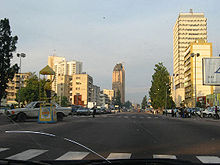 The Boulevard du 30 Juin, in downtown Kinshasa.
The Boulevard du 30 Juin, in downtown Kinshasa.
Internal transport
Several private companies whose Urban Transport Company (STUC) and the Public City train (12 cars in 2002) serves the city. The bus lines are:
- Gare centrale – Kingasani (municipality of Kimbanseke, reopened in September 2005);
- Kingasani – Marché central
- Matete – Royale (reopened in June 2006);
- Matete – UPN (reopened in June 2006);
- Rond-point Ngaba – UPN (reopened in June 2006).
- Rond-point Victoire – clinique Ngliema (opened in March 2007)
Other companies also provide public transport: Urbaco, Tshatu Trans, Socogetra, Gesac and MB Sprl. The city bus carries a maximum of 67,000 passengers per day. Several companies operate taxis and taxi-buses. The majority (95.8%) of transport is provided by individuals.
The city is considering the creation of a tramway in collaboration with public transport in Brussels (STIB), whose work could start in 2009 and would be completed around 2012–2015. The issue of electricity remains suspended.[26][27]
Rail
The ONATRA operates three lines of urban railways linking the town centre device, which goes to Bas-Congo.[28]
- The main line linking the Central Station to the N'djili Airport has 9 stations: Central Station, Ndolo, Amicongo, Uzam, Masina / Petro-Congo, Masina wireless Masina / Mapela, Masina / Neighborhood III, Masina / Siforco Camp Badara and Ndjili airport.
- The second line connects the Central Station in Kasangulu in Bas-Congo, through Matete, Riflart and Kimwenza.
- The third line at the Central Station Kinsuka-pumping in the town of Ngaliema.
In 2007, the internal rail network is being renovated with the help of Belgium.[29] This would serve Kintambo, Ndolo, Limete, Lemba, Kasangulu, Gombe, Ndjili and Masina.
External transport
Kinshasa is the major river port of the Congo. The port, called 'Le Beach Ngobila' extends for about 7 km (4 mi) along the river, comprising scores of quays and jetties with hundreds of boats and barges tied up. Ferries cross the river to Brazzaville, a distance of about 4 km (2 mi). River transport also connects to dozens of ports upstream, such as Kisangani and Bangui.
There are road and rail links to Matadi, the sea port in the Congo estuary 150 km (93 mi) from the Atlantic Ocean.
There are no rail links from Kinshasa further inland, and road connections to much of the rest of the country are few and in poor condition.
The city has two airports: N'djili Airport is the main airport with connections to other African countries as well as to Brussels, Paris and some other destinations. N'Dolo Airport, located close to the city center, is used for domestic flights only with small turboprop aircraft.
Conservation
Lola ya Bonobo
Founded by Claudine André in 1994, Lola ya Bonobo is the world's only sanctuary for orphaned bonobos.[30] Since 2002, the sanctuary has been located at Les Petites Chutes de la Lukaya, just outside of Kinshasa Lola ya Bonobo means 'paradise for bonobos' in Lingala, the main language of Kinshasa. In 2008, Lola ya Bonobo was home to 60 bonobos who live in 30 hectares of primary forest.
Although the bonobos are captive, they live in an environment similar to the wild. They can forage among dozens of edible plants and fruiting trees, compete for mating opportunities, and learn to avoid dangers such as stepping on venomous snakes just as they would in the wild. As a result, the bonobos at Lola ya Bonobo sanctuary, living in their forested microcosm, show all the naturally occurring behaviors observed in wild bonobos and also display some behaviors, such as tool use, that have not been observed in the wild.
The sanctuary protects wild bonobos because it allows for the enforcement of domestic and international conservation laws aimed at preventing the trade in live bonobos. The sanctuary also acts as a mouth piece for conservation efforts in DRC by educating thousands of Congolese visitors each year about the value of Congo's natural history, in particular the bonobo – their unique Congolese inheritance.
Kinshasans
- David Norris, scholar and politician, 2011 election candidate for President of Ireland
- D. J. Mbenga, professional basketball player for the Los Angeles Lakers in the US National Basketball Association.
- Christian Eyenga, professional basketball player and 2009 first round draft choice for the Cleveland Cavaliers in the US National Basketball Association.
- Dikembe Mutombo, retired professional basketball player, and the 2nd most prolific shot blocker of all-time in the National Basketball Association, second only to Hakeem Olajuwon.
- Jimmy Omonga, singer-songwriter.
- Ya Kid K, hip-hop artist.
- Guylain Ndumbu-Nsungu, former Sheffield Wednesday football player.
- Leki, R&B artist.
- Claude Makélélé, professional football player for Paris Saint-Germain in the French Ligue 1.
- Steve Mandanda, professional footballer who plays for Marseille and the France national football team.
- Ariza Makukula, naturalized Portuguese professional football player for Kayserispor in the Turkish Süper Lig, on loan from Sport Lisboa e Benfica of the Portuguese Liga.
- José Bosingwa, naturalized Portuguese football player for Chelsea of the Premier League in England.
- André Action Diakité Jackson or M’zée Fula-Ngenge, diamond mogul.
- Leroy Lita, professional football player for Welsh club Swansea City in the English Premier League.
- Fabrice Muamba, professional football player player for Bolton Wanderers in the Premier League.
- Odette Krempin, fashion designer.
- Tim Biakabutuka, former professional American football player.
- Kaysha, hip-hop artist.
- Kazenga LuaLua,professional football player for Newcastle United.
- Lomana LuaLua, professional football player for Al-Arabi in Qatar.
- Mwamba Kazadi, former professional football player player who won the 1973 "African Footballer of the Year" award.
- Peguy Luyindula, professional football player player for Paris Saint-Germain in the Ligue 1.
- Hérita Ilunga, professional football player player for West Ham United in the Premier League.
- Gary Kikaya, Olympic 400 metre runner
- Patrick Kabongo, professional football player for the Edmonton Eskimos of the Canadian Football League.
- Merveille Lukeba, professional actor for the series Skins on E4
- Mohombi, Pop, Hip Hop artist
- Youssouf Mulumbu, professional footballer for West Bromwich Albion
- Danny Mwanga, professional footballer for the Philadelphia Union
- Blaise Nkufo, professional footballer for Switzerland
- Didier Tsonga, former handball player
- Gabriel Zakuani, professional football player for Peterborough United of The Football League in England.
- Steve Zakuani, professional football player player for the Seattle Sounders of Major League Soccer in The United States.
Sister cities
 Bologna (Italy) starts soon[citation needed]
Bologna (Italy) starts soon[citation needed] Brazzaville (Republic of the Congo)
Brazzaville (Republic of the Congo) Brussels (Belgium) since 2002
Brussels (Belgium) since 2002 Dakar (Senegal)
Dakar (Senegal) Ankara (Turkey)
Ankara (Turkey)
See also
References
- ^ a b c (French) "Monographie de la Ville de Kinshasa" (SWF). Unité de Pilotage du Processus d'Elaboration et de mise œuvre de la Stratégie pour la Réduction de la Pauvreté (UPPE-SRP). http://www.dsrp-rdc.org/documents/Monographies_Provinciales/Monographie%20de%20la%20Province%20de%20Kinshasa.swf. Retrieved 19 January 2007.
- ^ "Programme du Gouvernement, Provincial de Kinshasa, 2007 – 2011". Ville de Kinshasa. 25 August 2009. http://www.kinshasa.cd/index.php?option=com_docman&Itemid=141&task=doc_download&gid=1. Retrieved 14 March 2011.
- ^ a b Géographie de Kinshasa, Ville de Kinshasa website, accessed 13 November 2009.
- ^ "Demographia World Urban Areas Projections 2007 & 2020" (PDF). Demographia. http://www.demographia.com/db-worldua2015.pdf. Retrieved 30 June 2007.[dead link]
- ^ "World Urbanization Prospects: The 2005 Revision Population Database". UN Population Division. http://esa.un.org/unup/index.asp?panel=2. Retrieved 30 June 2007.
- ^ http://www.nytimes.com/2011/10/18/health/18aids.html
- ^ Wachter, Sarah J. (19 June 2007). "Giant dam projects aim to transform African power supplies". New York Times. http://www.nytimes.com/2007/06/19/business/worldbusiness/19iht-rnrghydro.1.6204822.html. Retrieved 15 December 2010.
- ^ "Average Conditions Kinshasa, Congo Democratic Republic". BBC Weather. http://www.bbc.co.uk/weather/world/city_guides/results.shtml?tt=TT000770. Retrieved 27 March 2011.
- ^ "U.S. Dept. of State – Congo, Democratic Republic of the Country Specific Information". United States Department of State. http://travel.state.gov/travel/cis_pa_tw/cis/cis_1104.html. Retrieved 15 December 2010.
- ^ http://africacenter.org/wp-content/uploads/2010/09/AfricaBrief-7.pdf
- ^ World Street Children News :: Congo (DR) Streetkid News
- ^ Manson, Katrina (22 July 2010). "Congo's children battle witchcraft accusations". Reuters. http://www.reuters.com/article/idUSTRE66L2TB20100722?sp=true. Retrieved 14 March 2011.
- ^ "Street Children in Kinshasa". Africa Action. 8 July 2009. http://africaaction.typepad.com/justafrica/2009/07/african-street-children-kinshasa-drc.html. Retrieved 14 March 2011.
- ^ "A night on the streets with Kinshasa's 'child witches'". War Child UK – Warchild.org.uk. http://www.warchild.org.uk/our_projects/democratic_republic_of_congo/blog/child-witches-in-kinshasa. Retrieved 14 March 2011.
- ^ "Danballuff – Children of Congo: From War to Witches(video)". Gvnet.com. http://www.gvnet.com/streetchildren/Congo.htm. Retrieved 14 March 2011.
- ^ "Africa Feature: Around 20,000 street children wander in Kinshasa". English.people.com.cn. 1 June 2007. http://english.people.com.cn/200706/01/eng20070601_379840.html. Retrieved 14 March 2011.
- ^ "Prevalence, Abuse & Exploitation of Street Children". Gvnet.com. http://www.gvnet.com/streetchildren/Congo.htm. Retrieved 14 March 2011.
- ^ "Police shoot dead street child in Kinshasa". BBC News. 16 August 2001. http://news.bbc.co.uk/1/hi/world/africa/1494555.stm. Retrieved 14 March 2011.
- ^ "Cefacongo.org". Cefacongo.org. http://www.cefacongo.org/index.html. Retrieved 14 March 2011.
- ^ "Provincial Health Division of Kinshasa" African Development Information Services
- ^ "Democratic Republic of Congo country profile – Media". BBC News. http://news.bbc.co.uk/2/hi/africa/country_profiles/1076399.stm#media. Retrieved 15 December 2010.
- ^ "Africa South of the Sahara: Selected internet resources – Democratic Republic of the Congo – Newspapers – Kinshasa Newspapers". University of Stanford Library. http://www-sul.stanford.edu/depts/ssrg/africa/congok/congoknews.html. Retrieved 15 December 2010.
- ^ Nadeau, Jean-Benoit (2006). The Story of French. St. Martin's Press. p. 483. ISBN 0312341830, 9780312341831. The world's second-largest francophone city is not Montreal, Dakar, or Algiers, as most people would assume, but Kinshasa, capital of the former Zaire.
- ^ Trefon, Theodore (2004). Reinventing Order in the Congo: How People Respond to State Failure in Kinshasa. London and New York: Zed Books. p. 7. ISBN 1842774913, 9781842774915. http://books.google.com/books?id=5VAAHi93y0sC&pg=PA7&dq=Kinshasa+second+largest+French+city&ei=PeQiSt-yAojCyQSWqfijDw. Retrieved 31 May 2009. A third factor is simply a demographic one. At least one in ten Congolese live in Kinshasa. With its 6–7 million inhabitants, it is the second largest city in sub-Saharan Africa (after Lagos). It is also the second largest French-speaking city in the world, according to Paris (even though only a small percentage of Kinois speak French correctly).
- ^ Manning, Patrick (1998). Francophone sub-Saharan Africa: Democracy and Dependence, 1985–1995. London and New York: Cambridge University Press. p. 189. ISBN 0521645190, 9780521645195. http://books.google.com/books?id=LwzFF2FnbzMC&pg=PA189&dq=Kinshasa+second+largest+francophone+city&lr=&ei=T-0iSpzsEYOIzQTSl_XRBw. Retrieved 31 May 2009. The apostles of francophonie in the 1980s labelled Zaire as the second-largest francophone country, and Kinshasa as the second-largest francophone city. Yet Zaire seemed unlikely to escape a complex multilingualism. Lingala was the language of music, of presidential addresses, of daily life in government and in Kinshasa. But if Lingala was the spoken language of Kinshasa, it made little progress as a written language. French was the written language of the city – as seen in street signs, posters, newspapers and in government documents. French dominated plays and television as well as the press; French was the language of the national anthem and even for the doctrine of authenticity. Zairian researchers found French to be used in vertical relationsihps among people of uneven rank; people of equal rank, no matter how high, tended to speak Zairian languages among themselves. Given these limits, French might have lost its place to another of the leading languages of Zaire – Lingala, Tshiluba, or Swahili – except that teach of these languages also suffered from limitations on its growth.
- ^ (French) La Stib à Kinshasa ?, La Dernière Heure, 24 May 2007.
- ^ (Dutch) Werkt MIVB mee aan uitbouw tramnetwerk Kinshasa?[dead link]
- ^ (French) L’enfer des chemins de fer urbains kinois, Le Potentiel, 25 juillet 2005.
- ^ DRC CONGO: KINSHASHA | Railways Africa
- ^ "Sanctuary. A love story" (PDF). Educator. Environmental Education and Training Newsletter (United Nations Environment Programme) (2). 2007. http://www.unep.org/training/downloads/newsletter/eet_newsl_vol2.pdf. Retrieved 14 August 2008.
External links
- Official website of the city of Kinshasa
- BRAKIN, the fusion city of Brazzaville and Kinshasa, urban analysis seminar by TU Darmstadt, 2009
- Travel information and city guide for Kinshasa
- Solo Kinshasa a blog about Kinshasa
- Kim Gjerstad a blog and photos from Kinshasa (no longer updated)
- University of Kinshasa
- SDAROVIA Hospital in Kinshasa, DR Congo
- "Villes de RD Congo – Kinshasa" (in French). MONUC. 29 May 2006. http://www.monuc.org/news.aspx?newsID=11220. Retrieved 16 September 2008.
Maps
- Detailed Map of Kinshasa (PDF of 7.5 MB)
- Detailed Map of Kinshasa from l'UNJLC prior to being replaced by MONUC (this map contains more information on buildings than the MONUC map) (smaller PDF than MONUC map of 4.8 MB)
- MSN Map
Articles related to Kinshasa Communes of the city-province of Kinshasa Bandalungwa · Barumbu · Bumbu · Gombe · Kalamu · Kasa-Vubu · Kimbanseke · Kinshasa (commune) · Kintambo · Kisenso · Lemba · Limete · Lingwala · Makala · Maluku · Masina · Matete · Mont Ngafula · Ndjili · Ngaba · Ngaliema · Ngiri-Ngiri · Nsele · Selembao

 Geographic localeBoende (Tshuapa) • Bukavu (Sud-Kivu) • Bunia (Ituri) • Buta (Bas-Uele) • Gbadolite (Nord-Ubangi) • Gemena (Sud-Ubangi) • Goma (Nord-Kivu) • Inongo (Mai-Ndombe) • Isiro (Haut-Uele) • Lisala (Mongala) • Lodja (Sankuru) • Lubumbashi (Haut‑Katanga) • Luebo (Kasaï) • Kabinda (Lomami) • Kalemie (Tanganyika) • Kamina (Haut-Lomami) • Kananga (Lulua) • Kenge (Kwango) • Kinshasa • Kikwit (Kwilu) • Kindu (Maniema) • Kisangani (Tshopo) • Kolwezi (Lualaba) • Matadi (Kongo Central) • Mbandaka (Équateur) • Mbuji-Mayi (Kasaï Oriental)Provinces are shown between brackets
Geographic localeBoende (Tshuapa) • Bukavu (Sud-Kivu) • Bunia (Ituri) • Buta (Bas-Uele) • Gbadolite (Nord-Ubangi) • Gemena (Sud-Ubangi) • Goma (Nord-Kivu) • Inongo (Mai-Ndombe) • Isiro (Haut-Uele) • Lisala (Mongala) • Lodja (Sankuru) • Lubumbashi (Haut‑Katanga) • Luebo (Kasaï) • Kabinda (Lomami) • Kalemie (Tanganyika) • Kamina (Haut-Lomami) • Kananga (Lulua) • Kenge (Kwango) • Kinshasa • Kikwit (Kwilu) • Kindu (Maniema) • Kisangani (Tshopo) • Kolwezi (Lualaba) • Matadi (Kongo Central) • Mbandaka (Équateur) • Mbuji-Mayi (Kasaï Oriental)Provinces are shown between bracketsProvinces of the Democratic Republic of the Congo Current provinces Bandundu · Bas-Congo · Équateur · Kasai-Occidental · Kasai-Oriental · Katanga · Kinshasa · Maniema · Nord-Kivu · Orientale · Sud-Kivu · Ituri Interim Administration
Proposed provinces
(2005 Constitution)Bas-Uele · Équateur · Haut-Lomami · Haut-Katanga · Haut-Uele · Ituri · Kasaï · Kasaï oriental · Kongo central · Kwango · Kwilu · Lomami · Lualaba · Lulua · Mai-Ndombe · Maniema · Mongala · Nord-Kivu · Nord-Ubangi · Sankuru · Sud-Kivu · Sud-Ubangi · Tanganyika · Tshopo · Tshuapa · Kinshasa
1966 Sud-Katanga1962-1966 Cuvette-Centrale · Ubangi Province · Moyen-Congo · Lomami · Luluabourg · Sankuru · Sud-Kasaï · Unité Kasaïenne · Lualaba · Katanga Oriental · Nord-Katanga · Congo Central · Kwango · Kwilu · Mai-Ndombe · Maniema · Kivu Central · Nord-Kivu · Kibali-Ituri · Uele · Haut-Congo
Capitals of Africa Abuja, Nigeria
Accra, Ghana
Addis Ababa, Ethiopia
Algiers, Algeria
Antananarivo, Madagascar
Asmara, Eritrea
Bamako, Mali
Bangui, Central African Republic
Banjul, Gambia
Bissau, Guinea-Bissau
Bloemfontein, South Africa 1
Brazzaville, Rep. of the Congo
Bujumbura, Burundi
Cairo, Egypt
Cape Town, South Africa 2
Conakry, GuineaPort Louis, Mauritius
Porto-Novo, Benin
Praia, Cape Verde
Pretoria, South Africa 3
Rabat, Morocco
Saint-Denis, Réunion
São Tomé, São Tomé and Príncipe
Tripoli, Libya
Tunis, Tunisia
Victoria, Seychelles
Windhoek, Namibia
Yaoundé, Cameroon
Yamoussoukro, Côte d'Ivoire1 Judicial. 2 Parliamentary. 3 Executive. 4 An unrecognised or partially-recognised state.World's fifty most-populous urban areas Categories:- Kinshasa
- Capitals in Africa
- Communities on the Congo River
- Democratic Republic of the Congo–Republic of the Congo border crossings
- Populated places established in 1881
- Populated places in the Democratic Republic of the Congo
- Provinces of the Democratic Republic of the Congo
Wikimedia Foundation. 2010.

